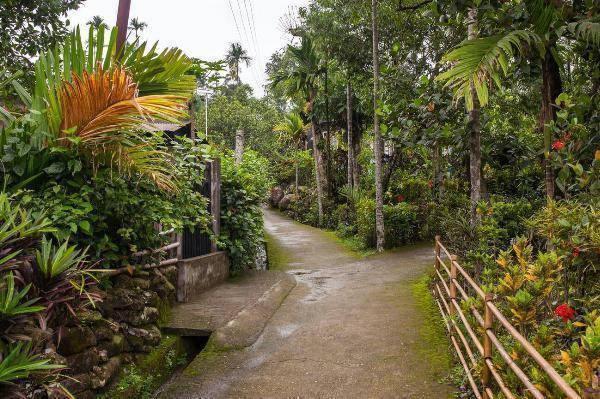Exploring Mawlynnong: Asia’s Cleanest Village

Strong 8k brings an ultra-HD IPTV experience to your living room and your pocket.
Mawlynnong has garnered global recognition as Asia's cleanest village. Known for its pristine beauty and meticulous cleanliness, Mawlynnong Cleanest Village offers a unique and refreshing experience for travelers seeking a beauty into harmonious living and sustainable practices. If you are planning to visit, here’s everything you need to know about Mawlynnong Cleanest Village, including its history, tourism highlights and what makes it stand out.
What Makes Mawlynnong the Cleanest Village?
Mawlynnong Village, located in the East Khasi Hills district of Meghalaya, is renowned for its extraordinary cleanliness and well-maintained surroundings. The title of Asia’s Cleanest Village is not just a matter of pride but a result of the dedicated efforts of its residents. The village’s commitment to cleanliness is evident in its litter-free streets, well-kept public spaces, and the natural beauty that enhances its charm.
Why is it so clean? The answer lies in the community’s collective effort and deep-rooted traditions. The residents of Mawlynnong practice strict waste management, with a focus on recycling and proper disposal. Bamboo dustbins can be seen on every street, and the villagers are vigilant about keeping their surroundings spotless. The community takes pride in their environment, which reflects in the village’s immaculate condition.
Mawlynnong Village History
The history of Mawlynnong Village is as fascinating as its current status. The village has been inhabited for generations by the Khasi tribe, one of the indigenous communities of Meghalaya. The Khasi people are known for their matrilineal society, where lineage and inheritance pass through the female line, a unique feature of their culture.
Historically, Mawlynnong has been a traditional village with a strong focus on community values and sustainable living. The emphasis on cleanliness and order is deeply ingrained in the Khasi culture, which values respect for nature and the environment. Over the years, this cultural respect has evolved into a structured approach to maintaining cleanliness, setting an example for others to follow.
Mawlynnong Village Tourism
Tourism in Mawlynnong is a delightful experience, offering visitors a chance to explore not just a clean village but a vibrant culture and stunning natural beauty. Here’s what to expect when you visit:
Scenic Beauty: Mawlynnong is surrounded by breathtaking landscapes, including lush green hills, serene waterfalls, and expansive forests. The picturesque scenery provides ample opportunities for nature photography and outdoor activities.
Living Root Bridges: One of the major attractions near Mawlynnong is the living root bridges, an architectural marvel created by weaving the roots of rubber trees. These bridges are not only functional but also a testament to the ingenuity and sustainable practices of the Khasi people.
Bamboo Crafts: The village is known for its bamboo crafts, which are crafted with exceptional skill. Visitors can purchase various bamboo items such as baskets, mats, and decorative pieces, all made by local artisans.
Traditional Khasi Cuisine: Sampling traditional Khasi food is a must when visiting Mawlynnong. The local cuisine features a variety of flavors and ingredients unique to the region. Dishes like ‘Jadoh’ (rice cooked with meat) and ‘Tungrymbai’ (fermented soybeans) offer an authentic taste of Khasi culture.
Village Tours: Guided tours around the village provide insights into the local way of life, including the community’s waste management practices, traditional customs, and daily activities. The tours are often conducted by local residents who share their knowledge and stories with visitors.
Community Involvement: The villagers themselves are often involved in tourism activities, offering visitors a genuine and immersive experience. Their hospitality and enthusiasm add a personal touch to the visit.
How to Get to Mawlynnong Village
Reaching Mawlynnong is relatively straightforward, though it requires some travel through Meghalaya’s picturesque yet winding roads. Here’s a simple guide to help you get there:
Travel to Shillong: The nearest major city is Shillong, the capital of Meghalaya. Shillong is well-connected by air, road, and rail to major cities like Guwahati. From Guwahati, which is approximately 100 kilometers (62 miles) away, you can take a taxi or bus to Shillong.
From Shillong to Mawlynnong: Mawlynnong is about 90 kilometers (56 miles) from Shillong. The journey takes around 2-3 hours by road. You can hire a taxi or join a local tour that includes transportation to the village.
Travel Tips: Ensure your vehicle is in good condition, as the roads can be rough and hilly. It’s also wise to check the weather conditions before traveling, as heavy rains can affect road conditions.
Mawlynnong Village Meghalaya: A Unique Experience
Mawlynnong’s reputation as the cleanest village in Asia is a testament to the power of community effort and environmental stewardship. The village serves as an exemplary model of how traditional values can harmonize with modern practices to create a sustainable and clean living environment. Visitors to Mawlynnong not only enjoy a pristine setting but also gain valuable insights into a culture that prioritizes cleanliness, respect for nature and community cohesion.
Whether you’re drawn by the village’s stunning beauty, its commitment to cleanliness or the chance to experience Khasi culture firsthand, Mawlynnong offers an amazing and memorable journey. The village stands as a beacon of sustainable living and environmental care, inviting travelers from across the globe to witness and learn from its remarkable example.
Note: IndiBlogHub features both user-submitted and editorial content. We do not verify third-party contributions. Read our Disclaimer and Privacy Policyfor details.


